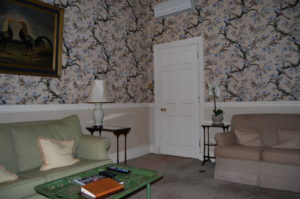Had we waited for the guided tour our friends mentioned we would have been disappointed. It was more a tour to than of the Temperate House, taking note of a few of the many significant trees in Kew Gardens and the vista we had already enjoyed before taking our preview in advance of most visitors. Once inside the tour soon ended.
That said, we were given some interesting information: for example, the crowned gates and straight avenue between Atlantic cedars (perhaps not there or certainly less tall than they are now) had been installed in anticipation of a railway station in the nineteenth century. Then the company decided to locate its station elsewhere. If Queen Victoria had expected a stately drive to the Temperate House she would not have been amused.
Even the need of a Temperate House had been questioned because people failed to understand the difference between temperate and tropical. The UK may have what is called a temperate climate but even with global warming most winters are too cold for temperate-zone plants and, as any reader of Dickens knows, winters were often much colder then than now. The range of these plants is from warm shores to lower hills around the world in sub-tropical regions. They need Mediterranean temperatures and even there have been severely threatened in some winters.
Lessons over – though the Royal Botanic Gardens are of course educational as well as scientific (not incompatible) – the refurbished building is magnificent. With some of the largest plants removed though replaced with smaller specimens it is light and spacious. I recall a sense of almost jungle density in visits prior to the refurbishment. Now there is room to read the labels, view the plants close up or at a comfortable distance. Also the landscape features are much easier to appreciate than before.
With busy lizzies along many borders the Temperate House would win no prizes at Chelsea but it reminds us that many of the plants we rely on in summer months have to come inside in autumn. Even a greenhouse without heat may not help them overwinter.
Like most of Kew Gardens the Temperate House has full disabled access, apart from the galleries of course. Only there, unfortunately if you can’t climb up, is the layout in geographic zones and environmental settings fully appreciated.
On previous visits we have gone to many other parts of the Gardens, even in a summer when the grass was only a beige memory. This time, however, the glory that is now the Temperate House was quite enough.










